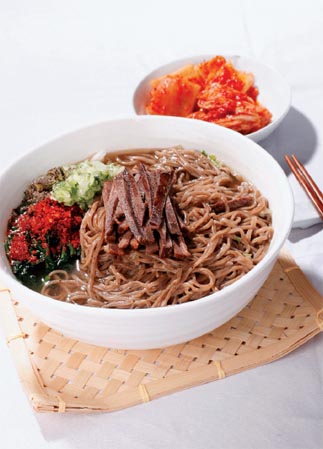Soba from Japan reborn with a Korean twist
Published: 25 Aug. 2010, 23:54

Uiryeong buckwheat soba Provided by the Korea Tourism Organization
Soba is served either chilled with a dipping sauce or in a warm broth. In Japan, it is common to refer to any thin noodle as soba, in contrast to udon, which are thick wheat noodles.
Enamored with the taste of soba, the townspeople beset the lady with requests to teach them how to make noodles with buckwheat. Eventually, as the fame of the dish spread, the lady opened a soba restaurant in an alley tucked away in the marketplace of Uiryeong.
That was the beginning of Uiryeong buckwheat soba.
Although “soba” is a Japanese word, the appearance and taste of Uiryeong buckwheat soba couldn’t be more different from that of the soba found in Japan. Some attribute the disparity to the existence of anti-Japanese sentiments following Korea’s liberation from Japanese colonial rule, as well as to the fact that the palates of Koreans and Japanese were markedly different.
In Korea, Japanese buckwheat soba, which is usually dipped in tsuyu (cold buckwheat soba stock), was reborn as rural Korean marketplace noodles. The soup stock of the Korean version of the noodles is made with dried anchovies rather than the skipjack tuna used in Japan. There were also regional variations on the noodles. Cold noodles were made in the north and warm noodles appeared in the south.
As with other traditional Korean dishes, garnish is placed on top of the dish just before it is served. In keeping with the yin-yang and five-elements theories, it is customary for Korean garnish to include at least five colors. In buckwheat soba also, colorful garnish puts the finishing touch on a delectable dish.
The ingredients are easily obtainable, and their colors include red (jangjorim, or beef boiled down in soy sauce), green (spinach), yellow (powdered sesame), white (the bottom of a spring onion) and black (powdered dried seaweed). Uiryeong’s buckwheat soba gained widespread popularity, warming the bellies of numerous workers at the marketplace. In particular, the jangjorim slices adorning the noodles complement the dish, as the taste of jangjorim becomes much softer and lingers in the mouth, producing a sweet taste if it is eaten after being soaked in dried anchovy stock.
Uiryeong buckwheat soba is both tasty and suitable to serve in a variety of settings: It is a popular inexpensive fast food, but is also served by exclusive and expensive specialty restaurants.
By Moon Dan-bee [estyle@joongang.co.kr]










with the Korea JoongAng Daily
To write comments, please log in to one of the accounts.
Standards Board Policy (0/250자)